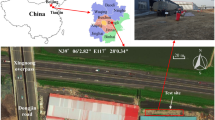Abstract
Anti-filtration recharge wells are commonly installed in river channels and irrigation canals on the Shandong Peninsula, China, and can be used as an important recharge facility for underground reservoirs. However, during recharge, as the running time increases, the recharge capacity gradually decreases. This study was undertaken to develop a new recharge well and mitigate this deficiency. A round empty core infiltration and anti-filtration recharge well and laboratory recharge test equipment were developed. Subsequently, 1:25 models of the recharge pond, a round empty core recharge wellhead, and an artificial recharge well were prepared. Using equal recharge levels and ambient groundwater levels, laboratory steady-flow recharge tests on the existing anti-filtration recharge well, the new round empty core infiltration and anti-filtration recharge well, and an artificial recharge well were carried out. Experimental data on the measured groundwater table and single-well recharge quantity were also collected and analyzed. The results showed that compared with the existing anti-filtration recharge well, the new round empty core infiltration and anti-filtration recharge well had stronger anti-deposition and anti-scouring properties, and the single-well recharge quantity increased by 403%. With an increase in the number of recharge tests, the single-well recharge quantity gradually decreased and tended to stabilize as a whole.
Similar content being viewed by others
References
Eastwood J C, Stanfield P J (2001). Key success factors in an ASR scheme. Q J Eng Geol Hydrogeol, 34(4): 399–109
Händel F, Liu G, Dietrich P, Liedl R, Butler J J Jr (2014). Numerical assessment of ASR recharge using small-diameter wells and surface basins. J Hydrol (Amst), 517(5): 54–63
Huang X D, Shu L C, Liu P G, Wang E (2009). Experimental study on clogging of recharge well. J Hydraul Eng, 40(4): 430–434 (in Chinese)
Leach B (1982). The development of a groundwater recharge model for Hong Kong. Hydrol Sci J, 27(4): 469–491
Li W L, Shu L C, Yin Z Z (2006a). Concept and design theory of groundwater reservoir. J Hydraul Eng, 37(5): 613–618 (in Chinese)
Li W L (2009). Structure design theory and method of recharge well with filter layer. Ground Water, 31(1): 126–129 (in Chinese)
Li W L, Shu L C, Li Y T (2006b). The calculation of steady state flow of confined-unconfined aquifer recharge well with filter layer. Engineering Survey, 5: 27–29 (in Chinese)
Li W L, Li Y T (2013). Present situation and improvement of recharge well with filter layer. Water Resources and Hydropower Engineering, 44(2): 48–50 (in Chinese)
Mahesha A (2001). Effect of strip recharge on sea water intrusion into aquifers. Hydrol Sci J, 46(2): 199–210
Phien-wej N, Giao P H, Nutalaya P (1998). Field experiment of artificial recharge through a well with reference to land subsidence control. Eng Geol, 50(1–2): 187–201
Rastogi A K, Pandey S N (1998). Modeling of artificial recharge basins of different shapes and effect on underlying aquifer system. J Hydrol Eng, 3(1): 62–68
Wu X F, Tang J (1998). Artificial recharge and reuse of groundwater. Engineering Investigation and Surveying, 4: 37–42
Acknowledgements
This work was financially supported by the Natural Science Foundation of Shandong Province (No. ZR2019MEE106), the Science and Technology Development Plans of Shandong Province (No. 2013GSF11606), and the Public Special Scientific Research of the Ministry of Water Resource (No. 201401024). All authors are very grateful to the editor and the three anonymous reviewers for their valuable comments, which have greatly improved the paper.
Author information
Authors and Affiliations
Corresponding author
Rights and permissions
About this article
Cite this article
Li, Y., Li, W., He, J. et al. Round empty core infiltration and anti-filtration recharge wells and laboratory recharge tests. Front. Earth Sci. 14, 298–305 (2020). https://doi.org/10.1007/s11707-019-0789-1
Received:
Accepted:
Published:
Issue Date:
DOI: https://doi.org/10.1007/s11707-019-0789-1




